
The taxonomy of Banksia integrifolia has a long and complex history, the result of confusion caused by the species' great variability, and similarities with some closely related species. The existence of hybrids between B. integrifolia and related species as well as early attempts to classify the species based on dried specimen material have also contributed to the confusion.
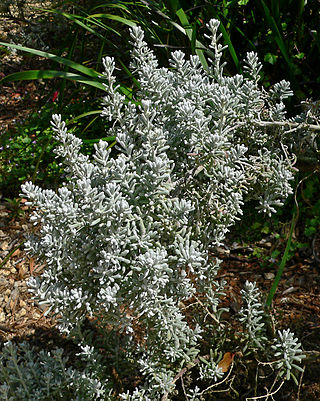
Maireana is a genus of around 57 species of perennial shrubs and herbs in the family Amaranthaceae which are endemic to Australia. Species in this genus were formerly classified within the genus Kochia. The genus was described in 1840 by the botanist, Moquin-Tandon and named to honour Joseph François Maire (1780-1867), an amateur botanist who befriended him during the author's first visit to Paris in 1834.
Conospermum acerosum, commonly known as needle-leaved smokebush, is a shrub endemic to Western Australia.
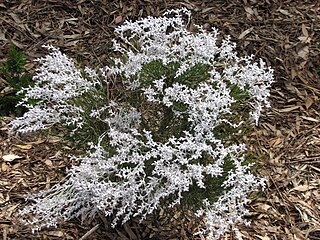
Conospermum stoechadis, commonly known as common smokebush, is a shrub endemic to Western Australia.

Atriplex cinerea, commonly known as grey saltbush, coast saltbush, barilla or truganini, is a plant species in the family Amaranthaceae. It occurs in sheltered coastal areas and around salt lakes in the Australian states of Western Australia, South Australia, Tasmania, Victoria and New South Wales.
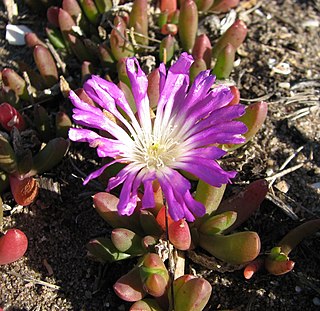
Disphyma crassifolium subsp. clavellatum is the subspecies of Disphyma crassifolium that occurs in Australia and New Zealand. It is sometimes known by the common name rounded noon-flower
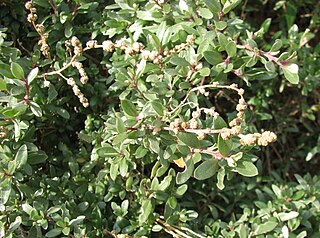
Atriplex paludosa, commonly known as marsh saltbush, is a species of saltbush endemic to Australia.
Atriplex paludosa subsp. baudinii is subspecies of Atriplex paludosa that is endemic to Western Australia.
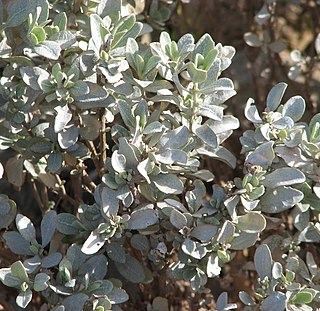
Atriplex vesicaria, commonly known as bladder saltbush, is a species of flowering plant of the family Amaranthaceae and is endemic to arid and semi-arid inland regions of Australia. It is an upright or sprawling shrub with scaly leaves and separate male and female plants, the fruit often with a bladder-like appendage.
Atriplex vesicaria subsp. variabilis is subspecies of bladder saltbush endemic to Australia.
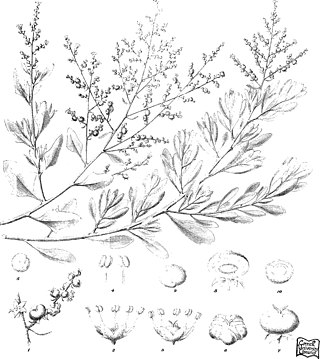
Chenopodium baccatum, commonly known as berry saltbush, is a species of shrub endemic to Western Australia.
Chenopodium benthamii is a species of shrub endemic to midwest Western Australia.
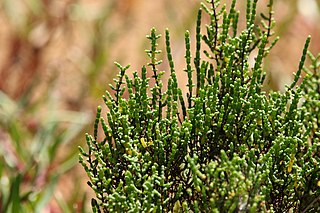
Tecticornia halocnemoides, commonly known as shrubby samphire or grey glasswort, is a species of succulent, salt tolerant plant endemic to Australia. It grows as a spreading or erect shrub up to fifty centimetres high. It was first published as Arthrocnemum halocnemoides in 1845, but transferred into Halosarcia in 1980, and into Tecticornia in 2007.

Muellerolimon salicorniaceum, the sole species in genus Muellerolimon, is a succulent perennial herb or shrub that grows on salt mudflats in Western Australia.
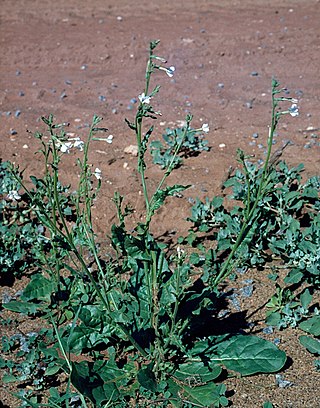
Nicotiana occidentalis, commonly known as native tobacco, is a short-lived herb endemic to Australia.

Trymalium is a genus of shrubs or trees in the family Rhamnaceae. The species are endemic to Western Australia but for one, Trymalium wayi, that occurs in South Australia. They are found in forest and semiarid woodland and shrubland of the kwongan in southwest Australia, and the outlying species of South Australia is found on rocky slopes, notably at the Mount Lofty and Flinders Ranges.
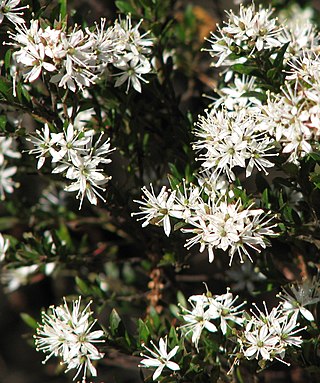
Leionema lamprophyllum, commonly known as shiny phebalium, is a shrub species that is endemic to Australia. It grows up to 2 metres in height, with leaves that are 3–10 mm long and 2–4 mm wide. White flowers are produced in spring.

Microcybe multiflora is a small shrub in the family Rutaceae. The species is endemic to Australia. It usually grows to between 0.2 and 1 metre high and produces cream to yellow flowers.

Eremophila hughesii is a flowering plant in the figwort family, Scrophulariaceae and is endemic to Australia. It is spindly, glabrous shrub with narrow leaves and with flowers that vary in colour from blue to pink, sometimes white. It is endemic to Western Australia and the Northern Territory.

Atriplex stipitata, commonly known as mallee saltbush, bitter saltbush and kidney saltbush, is a species of shrub in the family Amaranthaceae, found in all mainland states of Australia.













